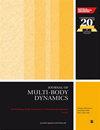基于MR阻尼器的半主动悬架提高轨道客运车辆临界速度的建模与分析
IF 1.9
4区 工程技术
Q3 ENGINEERING, MECHANICAL
Proceedings of the Institution of Mechanical Engineers Part K-Journal of Multi-Body Dynamics
Pub Date : 2022-05-04
DOI:10.1177/14644193221099136
引用次数: 2
摘要
发展中经济体通过建设高铁走廊和升级现有铁路基础设施来提高列车速度。车速过高会对车辆的稳定性和乘坐舒适性产生不利影响。因此,为了提高临界速度和乘坐舒适性,采用了基于磁流变的阻尼器。本文采用17自由度模型对印度铁路客运车辆的横向动力学进行了描述,并通过验证验证了悬架参数(如阻尼和刚度)对临界速度的影响。此外,进行了灵敏度分析,发现临界转速对二次侧向阻尼系数最为敏感。因此,这些阻尼器被MR流体阻尼器取代,以评估稳定性和临界速度的改善。提出了改进的Bouc-Wen模型来描述磁流变阻尼器的性能。本文采用两种不同的控制器:抗扰控制算法和阻尼力跟踪控制算法来控制整个系统。将测量到的随机航迹不规则性作为模拟系统的输入。结果表明:与现有的被动悬架相比,半主动悬架将临界速度提高了19.38 km/h(9.89%),并显著降低了列车高速行驶时车体宽频谱的振动响应。本文章由计算机程序翻译,如有差异,请以英文原文为准。
Modelling and analysis of passenger rail vehicle for the improvement of critical speed using MR damper based semi-active suspension
Developing economies focus to enhance train speed by introducing high speed corridors and upgrading existing rail infrastructure. Higher speed has adverse impact on vehicle stability and ride comfort. Therefore, in order to improve critical speed and ride comfort magneto-rheological (MR) based dampers are used. Here, the lateral dynamics of an Indian passenger rail vehicle is expressed with 17 degrees of freedom model and after validation, it is used to examine the effect of suspension parameters such as damping and stiffness on critical speed. Moreover, a sensitivity analysis is performed and it is found that critical speed is the most sensitive to secondary lateral damping coefficient. Therefore, these dampers are replaced with MR fluid dampers to evaluate improvement in stability and critical speed. The modified Bouc-Wen model is formulated to characterise the behaviour of the MR damper. Herein, two distinct controllers: disturbance refusal and damper force tracking control algorithms are employed to govern the entire system. Measured random track irregularities are applied as an input to simulate the system. The results reveal that the semi-active suspension improves the critical speed by 19.38 km/h (9.89%) when compared to the existing passive suspension, and significantly reduces the vibration responses of the carbody in a wide frequency spectrum at higher speeds of the train.
求助全文
通过发布文献求助,成功后即可免费获取论文全文。
去求助
来源期刊

CiteScore
4.10
自引率
11.10%
发文量
38
审稿时长
>12 weeks
期刊介绍:
The Journal of Multi-body Dynamics is a multi-disciplinary forum covering all aspects of mechanical design and dynamic analysis of multi-body systems. It is essential reading for academic and industrial research and development departments active in the mechanical design, monitoring and dynamic analysis of multi-body systems.
 求助内容:
求助内容: 应助结果提醒方式:
应助结果提醒方式:


